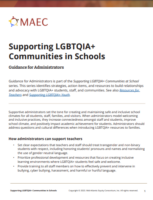
Download: Supporting LGBTQIA+ Communities - Administrators
Guidance for Administrators is part of the Supporting LGBTQIA+ Communities at School series. This series identifies strategies, action items, and resources to build relationships and advocacy with LGBTQIA+ students, staff, and communities. See also Resources for Teachers and Supporting LGBTQIA+ Youth.
Supporting LGBTQIA+ Communities in Schools
Guidance for Administrators
Supportive administrators set the tone for creating and maintaining safe and inclusive school climates for all students, staff, families, and visitors. When administrators model welcoming and inclusive practices, they increase connectedness amongst staff and students, improve school climate, and positively impact academic achievement for students. Administrators should address questions and cultural differences when introducing LGBTQIA+ resources to families.
How administrators can support teachers
- Set clear expectations that teachers and staff should treat transgender and non-binary students with respect, including honoring students’ pronouns and names and normalizing the use of gender neutral language.
- Prioritize professional development and resources that focus on creating inclusive learning environments where LGBTQIA+ students feel safe and welcome.
- Provide training to all staff members on how to effectively prevent and intervene in bullying, cyber bullying, harassment, and harmful or hurtful language.
How administrators can support students
- Use language that reflects the students’ name, pronouns, and gender identity. Be sure to inquire when and where it is appropriate to use names and pronouns, as students may be “out” at school but not at home.
- Confirm student permission before sharing aspects of their identity with others within the school. Be transparent about what you can and cannot keep private.
- Include LGBTQIA+ students in conversations about issues that affect them.
- Make resources and support for LGBTQIA+ youth readily available for students who need them.
- Ensure that resources for LGBTQIA+ youth and their families are accessible (e.g., written in multiple languages, acknowledge cultural backgrounds, etc.).
How administrators can support the school community
- Set and reinforce a vision and mission statement that is welcoming and inclusive of LGBTQIA+ students.
- Assess, strengthen, and monitor school climate on a regular and ongoing basis using focus groups, school climate surveys, and other qualitative data.
- Ensure that anti-bullying and harassment policies identify protections for LGBTQIA+ students.
- Where possible, update state student management systems to change names for nonbinary or trans students. If you’re unable, ensure any rosters are modified to exclude the student’s former (“dead”) name.
- Create culturally responsive learning opportunities to educate families and community members about gender identity and sexual orientation. Consider different cultures’ perceptions of gender identity and sexual orientation when designing and implementing learning opportunities.
How administrators can support the school district and beyond
- Learn terminology related to gender identity, sexual orientation, and issues that affect the LGBTQIA+ community.
- Research your state laws that affect LGBTQIA+ students.
- Advocate for district policies that support LGBTQIA+ students, especially transgender, non-binary and gender nonconforming students.
- Advocate for curricula that is inclusive of and uplifts the LGBTQIA+ community.
- Support school naming initiatives that honor legacies of LGBTQIA+ activists and leaders.
Selected resources for administrators
- How Educators Can Better Support LGBTQ Teachers of Color (Edutopia)
- Policy Recommendations to Support LGBTQ Staff and Students (GLSEN)
- Safe Zone Trainings (Safe Zone Project)
- Supporting LGBTQ Youth Through Family Engagement (GSA Network)
- Thriving, Not Just Surviving: How Administrators Can Support Trans & Non-Binary Students (MAEC)
Authors: Allegra Kogan and Marianna Stepniak, MAEC
MAEC is an education nonprofit dedicated to increasing access to high-quality education for culturally, linguistically, and economically diverse students. The Center for Education Equity (CEE), a project of MAEC, is the Region I Equity Assistance Center funded by the U.S. Department of Education under Title IV of the Civil Rights Act of 1964.
Our publications promote equitable education for the benefit of all students by identifying best practices as they have been developed over the years and in varying contexts. It is up to each school district, teacher, and student to figure out how best to align these best practices with their own experience to achieve their goals.
The contents of this guide were developed under a grant from the U.S. Department of Education under the Equity Assistance Centers Program. However, the contents of this guide do not necessarily represent the policy or views of the Department of Education, and you should not assume endorsement by the Department of Education or federal government, generally.
Copyright © 2023. Mid-Atlantic Equity Consortium, Inc. All rights reserved.
Suggested citation: Mid-Atlantic Equity Consortium, Inc. (2023). Supporting LGBTQIA+ Communities in Schools: Guidance for Administrators. Bethesda, MD. Edition: April 2023

